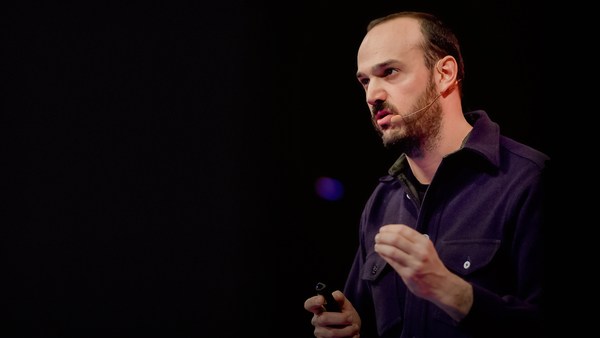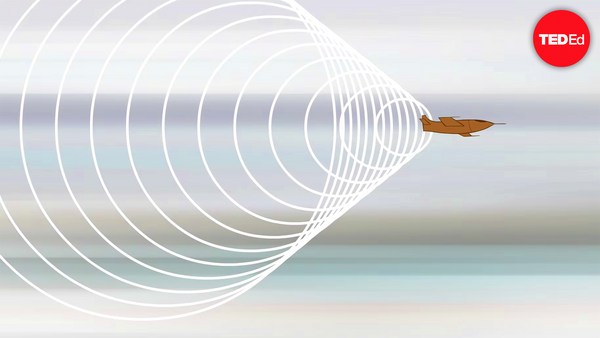(Beatboxing) Yo, what up? My name is Tom Thum, and I've got to say it's a pleasure to be back at TEDx. When I first stepped upon the Sydney stage in 2013 as a starry-eyed boy from Brisbane, I had no idea that I was about to deliver the most watched TEDx presentation ever.
(Laughter)
(Applause)
But you know, I was stoked because it was completely unexpected. However, standing before you today as a slightly inflated, time-battered version of myself five years later, I'm very confident.
(Laughter)
Confident that I'm about deliver the most instantly switched off and walked-out-on, vomit-inducing talk of all time. I'm about to show you things that I think you'll find hard to unsee, but all in the name of science. First, for those unfamiliar with what I do, I guess if you distilled it right down to its essence, you would call me a beatboxer.
(Beatboxing) Yo, for example ... here's a sample:
(Beatboxing)
(Rhythm changes)
(Hums a tune)
(Applause and cheers)
Thank you.
(Applause)
And being a beatboxer, it means that professionally, I am 100 percent reliant on the --
(Beatboxing) flexibility of the unfiltered human voice. And for years, my contemporaries and I have been fielding questions like, "Oh my God, that's so cool. When did you figure out you could do that?" After I practiced for thousands and thousands of hours --
(Laughter)
"And what do you do for a real job?" "I'm a full-time beatboxer, Your Honor." But there is one question that I get quite a lot that's a little bit more difficult to answer, and that is how are you doing it -- how are you making those noises? And I mean, I know muscle memory dictates where I position my lips in order to --
(Beatboxing)
but I have no idea about the inner mechanics of everything. You know, all the flappy bits and kind of dangly things and how they interact in --
(Laughter)
in a way that allows me to --
(Beatboxing)
To put it metaphorically, I know how to drive, I just don't know what's under the hood. So I decided to find out and invite 5,000 captive strangers, a few uncomfortable cameras, everybody watching online and their browser history into a place where not even the most intimate of encounters have been ... my throat. And to help me do that, I'd like to introduce to the stage a very specialist guest from the Queensland Voice Center, a man that's been in my mouth more times than I'd care to admit, a legend of the larynx, ENT doctor and laryngeal surgeon, Matthew Broadhurst.
(Applause and cheers)
MB: Thank you, Tom, thank you. And a very good evening everyone. It is a pleasure to be here on the TEDx stage tonight.
(Laughter)
Whoo.
(Laughter)
TT: He's not warming up his hands. It doesn't get that intimate.
MB: We set out a little while ago to try to go deep into the world -- and the throat -- of this beatboxer extraordinaire to try to understand how such a vast array of sounds are humanly possible. And what we found -- these are going in the mouth by the way -- and what we found was something absolutely amazing. Even after my two years of laryngeal surgery in Harvard Medical School with world-renowned professor Steven Zeitels, we never saw anything as extraordinary or fascinating as this, and that's what we're going to show you tonight.
(Laughter)
Alright, so for those of you who might be a little squeamish, the next 10 minutes or so will get incrementally more graphic and stomach-churning, so let's get into it --
TT: Feel free to use the bucket.
(Laughter)
MB: So when we make sound, we use the vocal cords to take air from the lungs and then turn it into a vibrating air column in the throat. If you think of it like a trumpet, we've got the mouthpiece -- that's the vocal folds -- and then the horn section is the throat. If we took your head off, took a bit of your neck off and left you as a torso with just your vocal folds vibrating, this is what you'd sound like.
(Flatulent sound)
TT: (High pitch)
MB: Pretty hard to communicate, but fortunately we've got a throat. We've got all the soft tissues, and that actually gives you all the incredible dynamics of sound that you'll hear tonight. Now, this is a rigid laryngoscope.
TT: Hmm, spicy boy.
(Laughter)
MB: I know, I know.
(Laughter)
10 millimeters in diameter, it gives us the highest resolution image of the larynx we can get. And we teed up with a stroboscope here and a trigger microphone. The mic will pick up the frequency and that will allow us to show you how this all works. So, if we can have the lights down?
TT: (Low pitch)
MB: Turn the light on here.
TT: (High and low pitches)
MB: So I've got the frequency of sound matched with the stroboscope. That's the light you're seeing flickering in the cup.
TT: (Low pitch)
MB: And that's at about 80 hertz or so. So what we can do then is we can take that and put the phase of the strobe and the sound just out of sync. That lets us capture real-time, slow-motion activity of vibrating tissues. When we apply that to the larynx, we get this fluid, slow-motion of the vibrating vocal folds. So that's what we're going to get on and do. Alright, you ready?
TT: Yup.
(Laughter)
MB: OK, so here we go. We're going to have a look at the voice box.
(Laughter) It's very hard not to gag with this. Say, "e."
TT: (Singing) E --
MB: So down the bottom you see the vocal cords, the little cord-like structures.
(Laughter)
And now just look at the skin on the neck and you'll see how strong the light is to penetrate the skin. Alright, so if you'll have the lights back on?
(Laughter)
(Applause)
Alright, so just give us a comfortable "e."
TT: (Singing) E.
(Laughter)
TT: (Singing) E.
(Audience gasps)
MB: So that's the vibrating vocal folds; about 120 hertz. Means they've collided 120 times a second just to make that sound. And we can also see that they're absolutely, perfectly normal. So all his beatboxing, all those sounds for years with Tom's way of doing it -- absolutely no damage whatsoever. That's really remarkable. Well done. OK.
TT: (High pitch) We've got this.
MB: So watch now as the vocal cords go from high pitch to low pitch. You'll see them go from long and skinny to short and fat. Really think "e."
TT: (High to low pitch) E.
MB: Right.
TT: (High to low pitch) E.
MB: And what you can see is that his vocal range is so extreme -- much more extreme than any other performer I've worked with -- the machine actually can't capture the really high pitches.
TT: (High pitch)
MB: So we know that whistle register is somewhere around 2,092 hertz. That means the vocal cords, well over 2,000 times a second, are banging together just to make that sound. That's really extraordinary. If you think about them, they're only 15 millimeters long, so that's barely the width of your thumb. That's incred --
(Laughter)
That's amazing this organ can do such a thing. So now we're going to swap over to the flexible laryngoscope. This is a little more graphic.
TT: He bought it at SEXPO.
(Laughter)
MB: That wasn't in the script.
(Laughter)
(Applause)
TT: Secondhand.
(Laughter)
MB: Now, we've had to time this bit perfectly because of the requirement for local anesthetic. You've got to numb the nose, get the camera in. It doesn't help for producing a lot of the sounds, but it gives us a really cool view of what's happening. So hold onto the stomachs, and let's see what we can do.
(Audience gasps)
So we're going to the back of the nose. And there you can see the soft palate. A lot of the sounds we make from day to day, even the simple ones, are incredibly complex. The sound "kh" for example. It's the soft palate sealing up precisely against the back of the nose. So if you say it loudly five times, feel your own soft palate snapping against the back of the throat. Kh, kh, kh, kh, kh, kh. Alright, so this is what it looks like when Tom does it.
TT: Kh, kh, kh, kh, kh. A cacophony of cackling kookaburras and cockatoos in Kakadu couldn't quite quit ketamine.
(Laughter)
(Applause)
MB: Alright, now in the beatboxing world, of course, they can use that for all sorts of different effects. I can help you.
TT: This is fine, we're professionals.
(Laughter)
(Beatboxing)
MB: Alright.
(Applause and cheers)
Now we're going to slide down a little further. If you'll just have the lights off and just see if you can see the light in the mouth somewhere. You'll be able to see exactly where the camera is at.
(Laughter)
TT: (Singing)
Surprise.
(Laughter)
MB: Alright.
(Audience gasps)
So what you can see there, that's the base of the tongue. The side walls of the screen, that's the pharynx. All muscle walls, and in the deep, dark decks is the larynx.
TT: Oh, should we have the lights back on? I think it's a good idea. It's getting a bit creepy with them off.
MB: Turn the lights on, thanks. Good. Now having examined over 15,000 larynxes and throats in my time, I can tell you that Tom's is as anatomically normal as anyone else's. It's just his unique use of all the muscles and soft tissues which lets him do all these amazing sounds that you're going to hear. So we will dissect some of these sounds for you now.
TT: It's in there really. Definitely.
(Laughter)
OK.
(High-pitched sounds)
(High-pitched sounds)
(Hooting)
MB: So what he's doing is he's changing the shape and the length of the vibrating air column using rhythmic contractions of all the muscles to generate all those sounds that you're hearing.
(Beatboxing)
(Laughter)
(Low pitch)
MB: And now there's rhythmic movements of the -- they're the arytenoid cartilages way down there, rocking back and forth to create that different sound.
TT: (Low pitch)
MB: And we like to call this "sphincter bass."
(Laughter)
And what you can see is that collapsing all the tissue down --
(Laughter)
allows a different kind of really deep bass note. Alright, so with local anesthetic on board, a big black hose in the nose, we're going to let loose a sliver of his repertoire and see all this in play. And we'll move -- careful.
TT: Can you pull it up just a smidgeon.
(Laughter)
TT: (Beatboxing) Maybe just a little more --
(Laughter)
Alright, cool, I think we're good.
(Beatboxing) To all my peeps who came to get deep, deep as the abyss -- check this.
(Beatboxing)
(Cheers)
(Applause)
(Beatboxing)
We start from the basics and build from scratch.
(Record scratch)
Yeah, like that.
(Beatboxing)
(Trumpet sound)
(Beatboxing)
(Beatboxing) Back to basics.
(Beatboxing)
(Beatboxing) You know the sound.
(Beatboxing) Make some noise.
(Applause and cheers)
(Whistling)
(Applause and cheers)
TT: Thank you so much.





